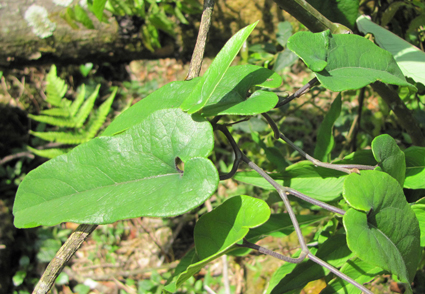Abstract
Aristolochia luudamcui (Aristolochia subgen. Siphisia, Aristolochiaceae), a new species from Vietnam, previously misidentified as A. utriformis, is described and illustrated here. The new species is most similar to A. pseudoutriformis and A. utriformis concerning the morphology of the leaf lamina, the color of the perianth, and the shape of the limb, but A. luudamcui can be distinguished from the other two species by having a deeply 3-lobed limb and a glabrous, yellow inner surface of limb lobes. A detailed description, information on ecology, phenology, distribution, usage, a provisional assessment of the conservation status of the new species, and a comparison with morphologically similar species are provided as well.
References
<p>Do, T.V., Luu, T.H., Wanke, S. & Neinhuis, C. (2015a) Three new species and three new records of<em> Aristolochia </em>subgenus <em>Siphisia </em>from Vietnam, including a key to the Asian species. <em>Systematic Botany </em>40: 671–691. https://doi.org/10.1600/036364415X689140</p>
<p>Do, T.V., Nguyen, H.V. & Le, K.D. (2021) <em>Aristolochia vuquangensis </em>(Aristolochiaceae), a new species from Central Vietnam. <em>Phytotaxa </em>500 (1): 037–044. https://doi.org/10.11646/phytotaxa.500.1.5</p>
<p>Do, T.V., Vu, T.T.H., Luu, H.T. & Nguyen, T.T. (2019) <em>Aristolochia nuichuaensis </em>(subgenus <em>Siphisia</em>, Aristolochiaceae), a new species, an updated key and a checklist to the species of <em>Siphisia </em>in Vietnam. <em>Annales Botanici Fennici </em>56: 107–113. https://doi.org/10.5735/085.056.0116</p>
<p>Do, T.V., Wanke, S., Neinhuis, C. & Pooma, R. (2015b) <em>Aristolochia phuphathanaphongiana</em> sp. nov. from southwestern Thailand. <em>Nordic Journal of Botany</em> 33: 567–571. https://doi.org/10.1111/njb.00889</p>
<p>Duchartre, P. (1854) Tentamen methodicae divisionis generis <em>Aristolochia</em>, additis descriptionibus complurium novarum specierum novique generis <em>Holostylis</em>. <em>Annales des Sciences Naturelles, 4a</em>. Sér. 2: 29–76.</p>
<p>Franchet, A.R. (1887) Plantae Davidianae ex sinarum imperio, Plantes du Thibet oriental, Province de Moupine. <em>Nouvelles Archives du Muséum d’Histoire Naturelle</em> Sér. 2 (10): 33–198.</p>
<p>Harris, J.G. & Harris, M.W. (2001) <em>Plant Identification Terminology: An Illustrated Glossary</em> (2nd). Spring Lake Pub., Spring Lake, Utah, 216 pp.</p>
<p>Huber, H. (1993) Aristolochiaceae. <em>In: </em>Kubitzki, K., Rohwer, J.G. & Bittrich, V. (Eds.) <em>The families and genera of vascular plants</em>. Springer, Berlin, pp. 129–137. https://doi.org/10.1007/978-3-662-02899-5_10</p>
<p>Hwang, S.M. (1981) Materials for Chinese <em>Aristolochia</em>. <em>Acta Phytotaxonomica Sinica </em>19: 222–231. [in Chinese]</p>
<p>Hwang, S.M., Kelly, L.M. & Gilbert, M.G. (2003) <em>Aristolochia </em>Linnaeus. <em>In</em>: Wu, Z.Y., Raven, P.H. & Hong, D.Y. (Eds.) <em>Flora of China </em>5. Science Press, Beijing & Missouri Botanical Garden Press, St. Louis, pp. 258–269.</p>
<p>IUCN (2012) <em>IUCN Red List Categories and Criteria, Version 3.1</em> (2<sup>nd</sup>Ed.) Gland and Cambridge, 32 pp.</p>
<p>IUCN Standards and Petitions Subcommittee (2019) <em>Guidelines for Using the IUCN Red List Categories and Criteria, Version 14</em>. Prepared by the Standards and Petitions Subcommittee. Available from: https://www.iucnredlist.org/resources/redlistguidelines (accessed 2 July 2021)</p>
<p>Liang, C.F. (1975) The Aristolochiaceae of Kwangsi Flora. <em>Acta Phytotaxonomica Sinica </em>13 (2): 10–28. [in Chinese]</p>
<p>Linnaeus, C. von (1753) <em>Species Plantarum </em>2. Impensis Laurentii Salvii, Holmiae [Stockholm], pp. 561–1200. https://doi.org/10.5962/bhl.title.669</p>
<p>Ma, J.S. (1989) A revision of <em>Aristolochia </em>Linn. from E. & S. Asia. <em>Acta Phytotaxonomica Sinica </em>27: 321–364. [in Chinese]</p>
<p>Schmidt, O.C. (1933) Beiträge zur Kenntnis der Aristolochiaceen. IV. <em>Repertorium Specierum Novarum Regni Vegetabilis</em> 32: 95–96. https://doi.org/10.1002/fedr.19330320104</p>
<p>Schmidt, O.C. (1935) Aristolochiaceae. <em>In</em>: Engler, A. & Prantl, K. (Eds.) <em>Die natürlichen Pflanzenfamilien</em>, vol. 2,16B. Engelmann, Leipzig, pp. 204–242.</p>
<p>Thiers, B.M. (2020 [continuously updated]) <em>Index Herbariorum: A global directory of public herbaria and associated staff</em>. New York Botanical Garden’s Virtual Herbarium. Available from: http://sweetgum.nybg.org/science/ih/ (accessed 2 July 2021)</p>
<p>Wanke, S., González, F. & Neinhuis, C. (2006) Systematics of pipevines: Combining morphological and fast-evolving molecular characters to investigate the relationships within subfamily Aristolochioideae (Aristolochiaceae). <em>International Journal of Plant Sciences </em>167: 1215–1227. https://doi.org/10.1086/508024</p>
<p>Wu, J.L. & Cheng, C.Y. (1987) New taxa of <em>Aristolochia</em> from Sichuan. <em>Journal of Wuhan Botanical Research </em>5: 219–225. [in Chinese]</p>
<p>Zhang, H. & Hsieh, C.K. (1984) Two new species of genus <em>Aristolochia</em>. <em>Acta Academiae Medicinae Sichuan </em>15: 12–16. [in Chinese]</p>
<p>Zhu, X.X., Li, X.Q., Liao, S., Li, G., & Ma, J. (2019) The taxonomic revision of Asian <em>Aristolochia </em>(Aristolochiaceae) V: two new species from Yunnan, China. <em>In</em>: Cai, J., Yu, W.B., Zhang, T. & Li, D.Z. (Eds.) Revealing the plant diversity in China’s biodiversity hotspots. <em>PhytoKeys </em>130: 93–106. https://doi.org/10.3897/phytokeys.130.33933</p>
<p>Zhu, X.X., Liao, S., Ma, Z.X., Xu, B., Wang, Z.H., Wang, Y. & Ma, J.S. (2017) The taxonomic revision of Asian <em>Aristolochia</em> (Aristolochiaceae) III: Two new taxa of Aristolochia and morphological revision for the flower character of <em>A. obliqua</em> from Yunnan, China. <em>Phytotaxa </em>332 (3): 269–279. https://doi.org/10.11646/phytotaxa.332.3.3</p>
<p>Zhu, X.X., Liao, S., Zhang, L., Wang, Z.H., Du, C. & Ma, J.S. (2016) The taxonomic revision of Asian <em>Aristolochia</em> (Aristolochiaceae) I: Confirmation and illustration of <em>A. austroszechuanica</em>, <em>A. faucimaculata</em> and <em>A. yunnanensis</em> var. <em>meionantha</em> from China. <em>Phytotaxa</em> 261 (1): 137–146. https://doi.org/10.11646/phytotaxa.261.2.3</p>
<p>Zhu, X.X., Shen, B., Sun, Z.P., Chen, B., Liao, S. & Ma, J.S. (2018) Two New Species of <em>Aristolochia </em>(Aristolochiaceae) from Yunnan, China. <em>Novon </em>26 (3): 298–306. https://doi.org/10.3417/2018066</p>


